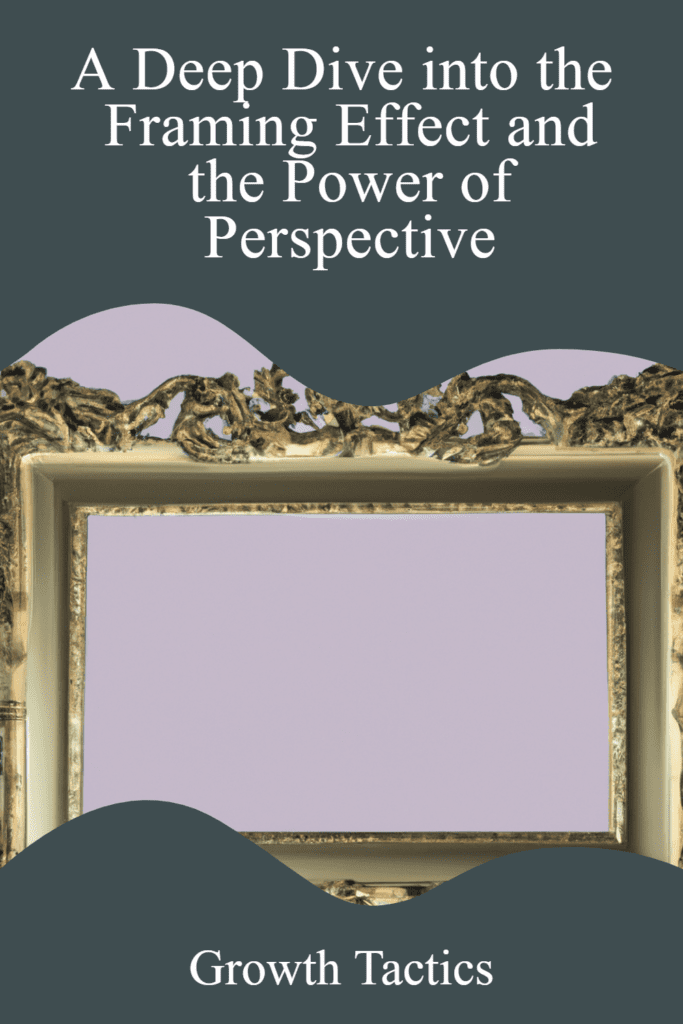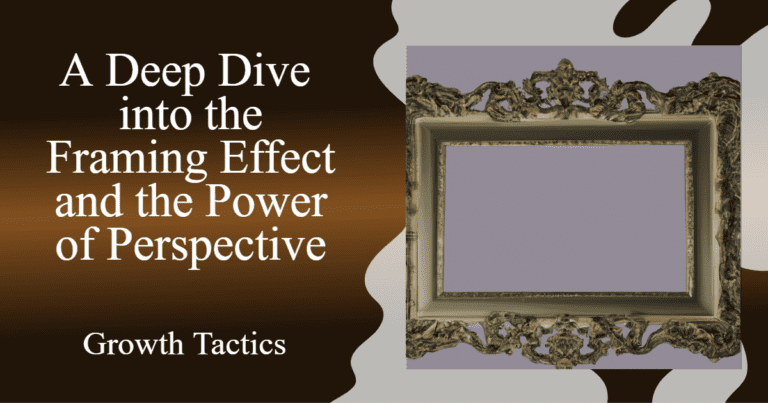The framing effect is a cognitive bias that deeply impacts our decision-making processes. It refers to the way people’s perceptions and decisions can be significantly influenced by how information is presented or “framed”. These frames can take the form of different wordings, settings, or contexts that can alter the substance of what is being communicated or decided upon. This highlights how the same facts can lead to entirely different conclusions based simply on the manner in which they’re presented.
Jump To Section
What is the Framing Effect
Frames play an integral role in shaping our decisions since they control the cognitive lens through which we perceive the world. Decisions rarely occur in a frameless vacuum; they are almost always interpreted through these contextual cues. Cognitive biases, like the framing effect, showcase our deviation from rational judgment. The framing effect, in particular, underscores our innate tendency to allow the presentation of information to cloud our judgment. Understanding the role and impact of these cognitive biases is pivotal to navigating effectively through our complex world of choices.
Types of Frames and Framing Effects
In the vast domain of decision-making, various types of frames come into play. Each frame has a unique propensity to sway our choices and understanding. Here are the primary types of frames and their potential impacts.
Gain-Loss Frames
Gain-loss frames hinge on representing outcomes in terms of potential gains or losses. A decision or outcome can be phrased in a positive, gain-focused way (emphasizing what one stands to achieve) or in a negative, loss-oriented way (highlighting what one stands to lose). Despite the outcomes being objectively the same, people generally exhibit greater aversion to losses than they do attraction to gains, a phenomenon rooted in prospect theory.
Attribute Framing
Attribute framing revolves around highlighting one key attribute of a decision or situation. The framing effect becomes evident when the emphasis on one attribute changes, and this shift alters people’s choices. For instance, a pair of shoes may be framed by emphasizing comfort or by highlighting style, with each attribute potentially attracting different sets of consumers.
Goal Framing
Goal framing involves framing a situation or decision in relation to a specific goal. It focuses on the end state and the potential fulfillment of an objective. The same action can elicit different responses when framed with different goals. For instance, running can be framed as a means to lose weight, gain energy, or improve mental health.
Issue Framing
Lastly, issue framing pertains to the presentation of complex issues, where alternative viewpoints are highlighted. This is frequently seen in political or media discourse, with differing frames offering divergent perspectives on the same issue. Depending on how an issue is framed, audiences may develop vastly different understandings and positions.
Throughout the exploration of these various framing types, it becomes evident that framing effects can significantly influence our decisions and perceptions, often unconsciously.
Examples of the Framing Effect in Action
The framing effect’s influence pervades many facets of life, from the justice system to the products we buy. To better understand its specific impacts, let’s examine a few illustrative scenarios.
The Plea Bargain Scenario
In the realm of criminal justice, the framing effect can be seen in the context of plea bargaining. When a defendant is presented with two options – to plead guilty with a framed “sentence reduction,” or go to trial with a risk of a heavier sentence, the choice might heavily rely on how options are framed. For example, a 30% chance of acquittal might push a defendant towards a trial, while a 70% chance of conviction might nudge them towards a plea bargain. The mathematical equivalence of these two frames tends to be overlooked due to the framing effect.
Marketing, Advertising, and Consumer Choices
The domain of marketing and advertising is ripe with examples of the framing effect. For instance, consumers might respond differently to a product if its efficiency is framed in terms of “99% success rate” versus “1% failure rate.” Even though both statements provide the same information, the positive framing can lead to higher sales due to its appeal to the consumer’s aversion to loss.
Politics and Media
Within politics and media, the framing effect significantly shapes public opinion and discourse. The same policy can elicit distinct reactions depending on its presentation. For instance, framing an economic policy as a “tax relief” might garner public support, while terming it as a “tax burden” could trigger opposition, despite the policy’s substance remaining constant.
These examples underscore the profound influence of the framing effect across varied domains. It serves as a potent reminder of the need to scrutinize the frames we encounter, maintaining an awareness of their potential to skew our decisions and perception of reality.
Prospect Theory: A Core Foundation for Understanding the Framing Effect
Delving deeper into the framing effect, it becomes essential to discuss its origins rooted in a fundamental behavioral economic theory – the prospect theory.
Overview of Prospect Theory
The prospect theory, coined by psychologists Daniel Kahneman and Amos Tversky, revolutionized our understanding of decision-making under uncertainty. It abandons the traditional economic assumption of people as rational actors always aiming to maximize utility. Instead, it posits that people make decisions based on potential gains and losses rather than final outcomes. Moreover, people weigh these gains and losses differently, leading to inconsistencies in their choices.
Loss Aversion as a Key Component
At the heart of the prospect theory lies the concept of loss aversion – the predisposition of individuals to strongly prefer avoiding losses over acquiring equivalent gains. To put it simply, losing $20 feels worse than finding $20 feels good. This tendency impacts a broad range of decisions, from our everyday choices to significant policy-making.
The Connection Between Prospect Theory and Framing Effects
The framing effect, through its manipulation of gain and loss perceptions, is intrinsically interwoven with prospect theory. For instance, framing a situation in terms of potential losses tends to induce a tendency toward risk-seeking behavior, as people strive to avoid losses. Conversely, when the same situation is framed in terms of potential gains, people exhibit risk aversion, gravitating towards the sure gain.
By marrying the concepts of framing effects and prospect theory, we can achieve a more profound understanding of how our choices are shaped not just by the objective attributes of a decision, but also by how those attributes are presented to us. This insight empowers us to become more discerning decision-makers, able to dissect the frames that surround us, and to make choices that are truly aligned with our goals and values.
The Power of Positive and Negative Framing
Framing effects are colored by the positive or negative light in which information is framed. Understanding the distinct influences of these two frames is pivotal in realizing the full extent of the framing effect.
How Positive Frames Can Enhance Motivation and Cooperation
Positive framing, which emphasizes the beneficial aspects of a decision or situation, can be a powerful tool to boost motivation and cooperation. For instance, in organizational settings, an employee is more likely to be motivated by the prospect of a bonus (a potential gain) for reaching a target, rather than the fear of a penalty for missing it. Similarly, cooperative behavior in team environments can be fostered by highlighting the benefits of collaboration, rather than the drawbacks of non-cooperation.
The Impact of Negative Frames on Risk-Taking and Decision-Making
Conversely, negative framing underscores the potential downsides or risks associated with a decision. When faced with potential losses, people tend to exhibit risk-seeking behavior as a means to avoid those losses. This propensity, rooted in loss aversion, can lead to rash decisions that may not align with an individual’s long-term goals.
Balancing Between Positive and Negative Frames for Optimal Outcomes
Effective decision-making often demands a balance between positive and negative frames. Recognizing the motivational power of positive frames and the caution-inducing effects of negative ones can help individuals and organizations create a balanced decision-making environment. By fostering awareness of how frames influence our choices, we can develop strategies to shift frames intentionally and adopt a balanced perspective that considers both gains and losses.
Ultimately, the capability to shift and balance between frames aids us in harnessing the power of perspective, ensuring that our decisions are holistically conscious and calculated, rather than being subjugated by the sway of a single frame.
How to Recognize and Counter the Framing Effect in Personal and Professional Decisions
Recognizing the Framing Effect
- Identify the Presentation of Information:
- Personal Context: Pay attention to how options or outcomes are worded in personal decisions. For instance, consider whether the choice is framed in terms of potential gains (e.g., “You will save $50 by buying this product now”) or potential losses (e.g., “You will lose $50 if you don’t buy this product now”).
- Professional Context: Notice if business scenarios are presented with a focus on positive results (e.g., “Our strategy will increase market share by 10%”) or negative consequences (e.g., “We will lose market share if we do not change our strategy”).
- Assess the Emotional Response:
- Personal Context: Reflect on whether the framing of information triggers a strong emotional reaction (e.g., fear, excitement, aversion) which might cloud your judgment.
- Professional Context: Consider whether emotional responses to information (e.g., anxiety about potential losses) are influencing decisions within your team or organization.
Strategies to Counter the Framing Effect
- Reframe the Information:
- Personal Context: Practice rephrasing the same information in different ways to neutralize emotional bias. For instance, if a medical procedure is presented as “90% success rate,” also consider it as “10% failure rate” to get a balanced perspective.
- Professional Context: Encourage your team to reframe business cases in both positive and negative terms. For example, if a project proposal highlights benefits, also discuss potential risks and how they will be managed.
- Seek Objective Data:
- Personal Context: Base your decisions on concrete data rather than emotional framing. For instance, before making a big purchase decision, compare product specifications, reviews, and costs objectively.
- Professional Context: Use data analytics and performance metrics to guide business decisions. This helps in mitigating the biases introduced by positive or negative frames.
- Consider the Long-Term Impact:
- Personal Context: Evaluate how decisions framed in different lights will affect your long-term goals. For example, when deciding on a job offer, consider both the pros and cons and their impact on your career growth in the long run.
- Professional Context: Make strategic decisions by considering their long-term implications for the company rather than short-term wins or losses as framed in proposals.
- Encourage Diverse Perspectives:
- Personal Context: Discuss major decisions with trusted friends or family members who can offer different viewpoints and help you see beyond the initial framing.
- Professional Context: Foster a culture of diverse opinions within your team. Regularly consult different departments or external advisors to get varied perspectives on critical business issues.
- Implement Decision-Making Frameworks:
- Personal Context: Use structured decision-making tools like pros and cons lists, decision trees, or cost-benefit analyses to evaluate options objectively.
- Professional Context: Apply established frameworks such as SWOT analysis (Strengths, Weaknesses, Opportunities, Threats) or risk assessment matrices to inform strategic business decisions.
By actively recognizing the framing effect and using these strategies, individuals and organizations can make more rational, balanced decisions that align with their true objectives and values.
In conclusion, by integrating awareness, reframing techniques, and critical reasoning, we can not only mitigate the framing effect in our decision-making process but also learn to adroitly use it to our advantage.


